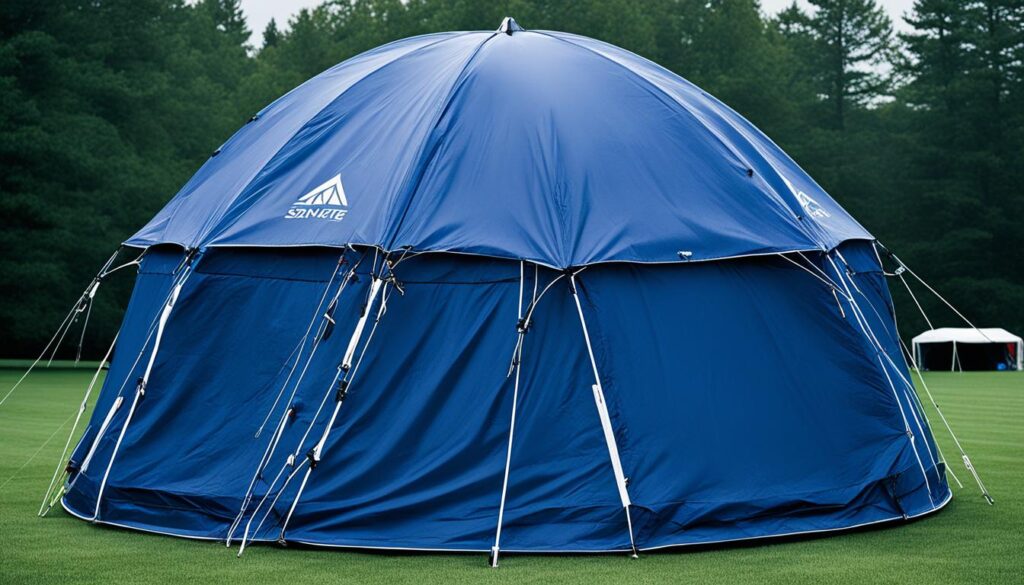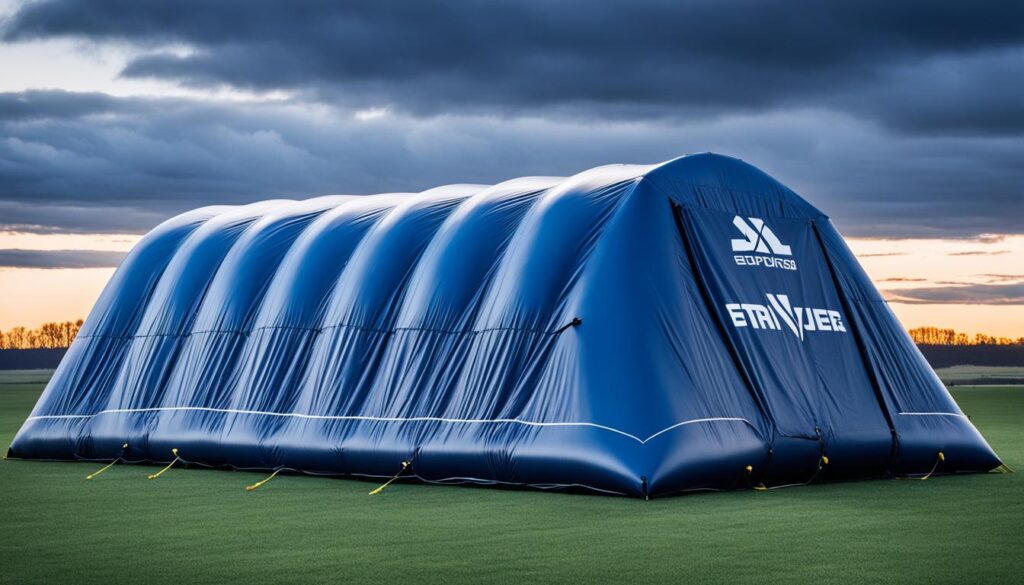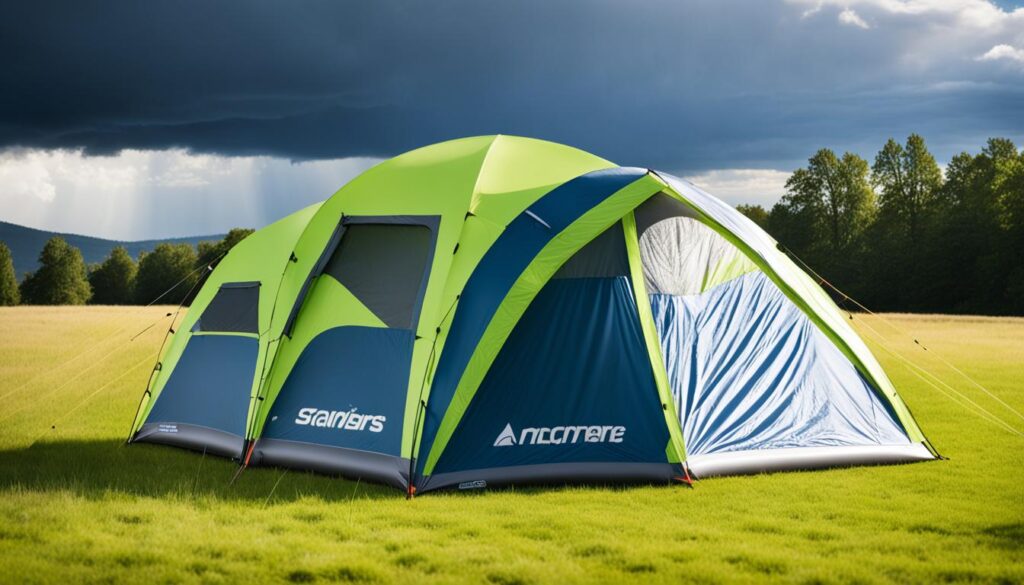
Imagine being out in the wilderness, surrounded by majestic mountains and breathtaking landscapes. The serenity of nature embraces you, filling your heart with a sense of peace and wonder. But suddenly, dark clouds roll in, and the once serene atmosphere transforms into a fierce battleground between nature’s elements. Strong winds howl, rain pelts down relentlessly, and you find yourself in the middle of a storm.
In moments like these, having a reliable and weather-resistant tent can make all the difference. Your inflatable tent becomes your sanctuary, your shield against the forces of nature. It becomes the barrier between you and the unpredictable and sometimes harsh weather conditions that nature throws your way.
But how can you ensure that your inflatable tent is up to the challenge? How can you enhance its safety and resilience to withstand the harshest of weather conditions? In this article, we will explore various ways to upgrade and reinforce your inflatable tent, providing you with the knowledge and tips to make your camping adventures safer and more enjoyable.
Key Takeaways:
- Enhancing your inflatable tent is crucial for camping in extreme weather conditions.
- Tent modifications, upgrades, and accessories can help protect your tent and improve its durability.
- Consider tent reinforcement techniques to strengthen your tent structure.
- Weatherproof tent accessories are essential for added protection.
- Key features of a durable inflatable tent include sturdy materials and reinforced seams.
Best Inflatable Camping Tents for Extreme Weather.
When it comes to camping in extreme weather conditions, having a reliable and durable inflatable tent is crucial for your safety and comfort. To help you find the best inflatable camping tent for your needs, we have researched and reviewed some top-rated options on the market. These tents are specifically designed to withstand harsh elements and provide optimal protection against wind, rain, and other challenging weather conditions.
Below are our top recommendations based on their features, durability, and overall performance:
| Tent | Features | Durability | Weatherproof | Price |
|---|---|---|---|---|
| Eureka! Copper Canyon LX | Anodized aluminum poles for stability Spacious design with standing room Zippered windows and mesh panels for ventilation | Strong and durable materials Reinforced seams for added strength | Waterproof rainfly and bathtub floor Weather-resistant fabric | $299.95 |
| Big Agnes Flying Diamond 6 Tent | Two vestibules for storage Multiple doors for easy access Color-coded setup for convenience | Robust construction Sturdy poles and zippers | Waterproof rainfly and floor Seam-taped seams for enhanced water resistance | $499.95 |
| Vango Odyssey Air 600 Tent | Inflatable AirBeam technology for quick setup Spacious sleeping and living area TBS II tension band system for stability | Durable and high-quality materials Reinforced corners and guy lines | Protex 70D flysheet with a hydrostatic head of 4000mm Fully weatherproof construction | $649.00 |
These inflatable camping tents are highly recommended for their outstanding performance in extreme weather conditions. Whether you’re camping in heavy rain, strong winds, or scorching heat, these tents have proven their durability and weatherproof capabilities. Compare their features, durability, and prices to choose the tent that best suits your needs and preferences.
Remember, investing in a high-quality inflatable tent will not only ensure your safety and comfort but also provide you with a reliable shelter that can withstand the toughest weather conditions during your outdoor adventures.
Stay tuned for the next section, where we will explore effective tent reinforcement techniques to further enhance the resilience of your inflatable tent for extreme weather conditions.
Tent Reinforcement Techniques.
When it comes to preparing your inflatable tent for extreme weather conditions, tent reinforcement is essential. Strengthening the structure of your tent and weatherproofing it can significantly increase its resilience and durability. In this section, we will explore various tent reinforcement techniques that will help safeguard your inflatable tent against the harshest elements.
1. Choose a Sturdy Tent Material
Opting for a tent made from durable and weather-resistant materials is the first step in reinforcing your inflatable tent. Look for tents constructed with high-quality fabrics such as ripstop nylon or polyester, as they are known for their strength and ability to withstand rough conditions. These materials are less likely to tear or get damaged in strong winds or heavy rain.
2. Reinforce Tent Seams
The seams of your inflatable tent are vulnerable points that may weaken over time or in extreme weather. To reinforce these seams, apply seam sealer or tape to ensure that they remain watertight and resistant to wind. This simple step can go a long way in strengthening the overall structure of your tent.
3. Add Extra Guy Lines
Adding extra guy lines to your inflatable tent can provide additional stability and prevent it from being blown away by strong winds. Attach the guy lines securely to the appropriate anchor points on your tent and stake them properly into the ground. Keep the lines taut to further reinforce the stability of your tent.
4. Invest in Tent Pole Repair Kits
Inflatable tents often rely on flexible poles for support. However, these poles can become damaged or bent in extreme weather conditions. To strengthen your tent’s structure, consider investing in a tent pole repair kit. These kits typically include spare pole sections, connectors, and shock cords that allow you to easily repair or replace damaged poles on the go. Properly functioning tent poles are crucial for maintaining the shape and stability of your tent.
5. Use Tent Footprints
Tent footprints are protective ground sheets that act as an additional barrier between your inflatable tent and the ground. They provide an extra layer of insulation and protection against moisture, sharp objects, and rough terrain. Using a tent footprint not only enhances the durability of your tent’s floor but also helps prevent water seepage during heavy rain.
“Tent reinforcement techniques such as choosing sturdy materials, reinforcing seams, adding extra guy lines, investing in tent pole repair kits, and using tent footprints can significantly improve the resilience and strength of your inflatable tent.”
By implementing these tent reinforcement techniques, you can make your inflatable tent more resistant to extreme weather conditions, ensuring a safer and more enjoyable camping experience. Remember, taking proactive steps to weatherproof your tent before heading into the outdoors can save you from potential damage and provide peace of mind during your adventures.

Weatherproof Tent Accessories.
When it comes to camping in extreme weather conditions, having the right tent accessories is crucial. These weatherproof accessories can enhance the protection and performance of your inflatable tent, ensuring a comfortable and safe outdoor experience. In this section, we will explore some essential weatherproof tent accessories, including rainflys, tent footprints, and tent stakes.
Rainflys

One of the most important weatherproof tent accessories is a rainfly. This additional covering fits over your inflatable tent, providing an extra layer of protection against rain, wind, and snow. A rainfly acts as a waterproof barrier, preventing water from seeping into the tent and keeping you dry during those unexpected downpours. It also helps to reduce condensation inside the tent, improving ventilation and comfort.
Tent Footprints
A tent footprint is a groundsheet that is placed beneath your tent to protect the bottom from rocks, sharp objects, and moisture. These footprints are designed to be durable and waterproof, preventing wear and tear on the tent floor and enhancing its longevity. They also provide an added layer of insulation, keeping you warmer when camping in colder climates. Tent footprints are available in various sizes and shapes to fit specific tent models, ensuring a perfect fit.
Tent Stakes
Tent stakes are essential for securing your inflatable tent to the ground, especially in windy conditions. These sturdy stakes anchor the tent, preventing it from being blown away or collapsing. Look for tent stakes that are made from durable materials like aluminum or steel, as they offer better stability and longevity. It’s also useful to have a mallet or hammer to help drive the stakes into the ground effectively.
By investing in weatherproof tent accessories like rainflys, tent footprints, and tent stakes, you can significantly enhance the protection and stability of your inflatable tent. These accessories will help ensure that your tent can withstand extreme weather conditions, keeping you dry, comfortable, and safe during your outdoor adventures.
Key Features of a Durable Inflatable Tent.
When choosing an inflatable tent for extreme weather conditions, it is crucial to prioritize durability and resilience. To ensure maximum protection and longevity, here are the key features you should look for:
Sturdy Tent Materials
Opt for tents made from high-quality, durable materials such as ripstop nylon or polyester. These materials are known for their strength and resistance to tears, ensuring your tent can withstand harsh weather conditions.
Reinforced Tent Seams
Check if the tent seams are reinforced with double stitching or tape. This extra layer of strength prevents water from seeping through the seams during heavy rainfall or strong winds, keeping you dry and protected.
Heavy-Duty Tent Zippers
Make sure the tent is equipped with heavy-duty zippers that are resistant to wear and tear. These zippers are designed to withstand frequent use and pressure, allowing for easy and secure access to your tent.
UV-Resistant Tent Fabric
Look for tents with UV-resistant fabric to protect you from harmful sun rays. This feature not only adds longevity to your tent but also provides a safer and more comfortable environment inside.
| Feature | Benefits |
|---|---|
| Sturdy Tent Materials | Increased strength and resistance to tears |
| Reinforced Tent Seams | Prevents water leakage and enhances weather protection |
| Heavy-Duty Tent Zippers | Durable and reliable access to the tent |
| UV-Resistant Tent Fabric | Protection against harmful sun rays |
An inflatable tent equipped with these durable features will provide you with a reliable and long-lasting shelter, ensuring your safety and comfort even in the most extreme weather conditions.
Tips for Setting Up and Packing Down Inflatable Tents.
Setting up and packing down inflatable tents efficiently is essential for a seamless camping experience. Whether you’re a seasoned camper or a beginner, these tips and techniques will guide you through the process, ensuring that you can enjoy your outdoor adventures without any hassle.
Setting Up
1. Find a suitable location:
- Look for a flat and clear area free from rocks, branches, or any sharp objects that may damage your inflatable tent.
- Ensure the ground is firm enough to provide stability.
2. Lay out the tent:
- Unfold the tent and lay it flat on the ground.
- Make sure all the zippers are closed before inflating.
3. Inflate the tent:
- Locate the air valve and remove the cap.
- Attach the pump to the valve and start inflating the tent.
- Monitor the inflation process to prevent overinflation.
4. Secure the tent:
- Once the tent is fully inflated, secure it using the provided stakes and guy lines.
- Tension the guy lines to ensure stability in windy conditions.
Packing Down
1. Deflate the tent:
- Remove the stakes and guy lines.
- Open the air valve and allow the tent to deflate.
- Press down gently on the tent to expel any remaining air.
2. Fold the tent:
- Start folding the tent from one corner towards the opposite corner.
- Continue folding until you reach the center of the tent.
3. Roll up the tent:
- Roll the folded tent tightly from one end to the other.
- Avoid rolling too loosely to prevent unnecessary bulk.
4. Pack the tent:
- Place the rolled tent inside its storage bag.
- Ensure the bag is securely closed to prevent any damage or loss.
No matter how big or small your inflatable tent is, following these tips will help you set up and pack down your tent efficiently. Remember to always check the manufacturer’s instructions for specific guidelines related to your tent model.
Conclusion.
In conclusion, enhancing the safety and resilience of inflatable tents for extreme weather conditions is crucial for a comfortable and secure outdoor experience. By implementing the following tips and recommendations, you can weatherproof your tent and ensure maximum protection:
1. Reinforce the tent structure: Strengthen the structure of your inflatable tent by using additional guylines, reinforcing the seams, and adding extra supports such as poles or braces. This will improve stability and prevent damage in high winds or heavy rain.
2. Invest in weatherproof accessories: Consider purchasing weatherproof tent accessories such as a rainfly, tent footprint, and durable tent stakes. These accessories will provide an extra layer of protection against rain, wind, and rough terrain.
3. Choose a durable tent: Look for inflatable tents made with sturdy materials, reinforced seams, heavy-duty zippers, and UV-resistant fabric. These key features will ensure the longevity and resilience of your tent in extreme weather conditions.
By following these tips, you can enhance the performance of your inflatable tent and enjoy your outdoor adventures with confidence, knowing that your tent is well-prepared to withstand the elements. Stay safe, stay comfortable, and embrace the beauty of nature!
Recommended
- BEST BED TENT TO BLOCK OUT LIGHT FOR SLEEP
- BED TENT FOR TRAVEL: SLEEP COZY ON-THE-GO
- INDOOR BED TENT FOR CAMPING COMFORT & FUN

Meet Noah, the soul behind “Best Inflatable Tent” and a true wanderer at heart. Living the van life, Noah has turned his passion for exploring the great outdoors into a lifestyle, earning his living through organizing group travels that bring people closer to nature. With years of firsthand experience in the wild, Noah’s expertise in selecting and utilizing inflatable tents is unparalleled. Through this blog, he shares his profound knowledge and practical tips to help fellow adventurers find their perfect outdoor shelters. Noah’s commitment to delivering genuine, tested insights has made him a trusted authority in the camping community. Join him on this journey to discover the best inflatable tents that make the great outdoors feel like home.